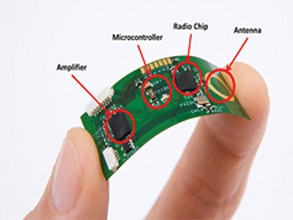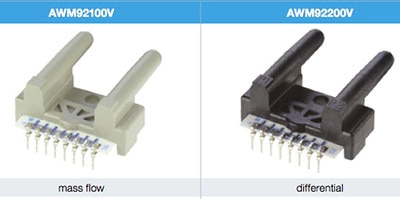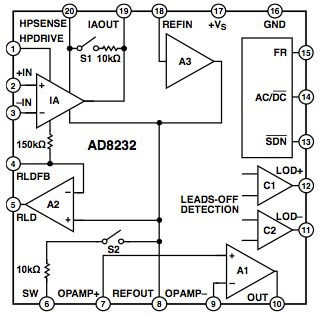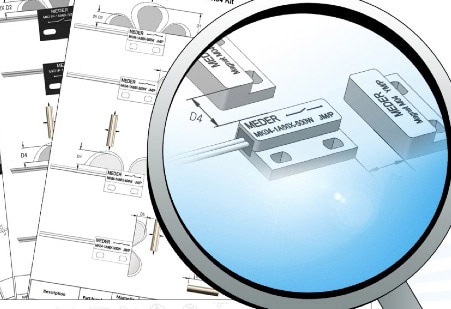Making the World Healthier and Safer through Sensor Innovation
投稿人:电子产品
2015-05-21
Used in a variety of applications ranging from heart-rate monitors to vehicle-crash detectors, carbon-monoxide indicators to human bladder-pressure measuring devices, a wide range of powerful, reliable, and less costly sensors have emerged whose paramount application is to mitigate injury and reduce or predict health risks at a time when people are increasingly looking for new ways to take control of their personal well-being in order to live healthier and better lives. This article will examine existing designs as well as those on the drawing board which, without these sensors, could never exist, no less help to avoid loss of life. All parts, data sheets, tutorials, and development systems referenced here can be found on the DigiKey website.
Growing medical applications
Fitness and vital-sign medical sensor applications have been on the market for a while now, but new developments are taking sensors further into untapped medical environments. For example, physiological monitoring could help in both diagnosis and ongoing treatment of a vast number of individuals with neurological, cardiovascular, and pulmonary diseases such as seizures, hypertension, and asthma.
Recent developments in the field of microelectronics have allowed researchers to develop miniature circuits entailing sensing capability, front-end amplification, microcontroller functions, and radio transmission, all in a wearable form-factor (for example, the flexible ECG unit from IMEC, shown in Figure 1).

Figure 1: A flexible wireless ECG sensor with a fully functional microcontroller by IMEC.
Philips, working in conjunction with Nijmegen, NL-based Radboud University Medical Center, has come up with a new wearable diagnostic device for people suffering from chronic obstructive pulmonary disease (COPD). Once a COPD patient has left the hospital, the diagnostic prototype that uses a biosensor module worn inside a disposable adhesive patch, collects data day and night – including physical activity/inactivity, respiratory indication, heart rhythm, and heart-rate variability. This data is then sent via the cloud to the company’s HealthSuite Digital Platform, where it is shared with the appropriate care providers via a patient portal app accessed via a tablet and presenting a more complete view of the patient’s illness.
Sensors are being successfully used in the treatment of sleep apnea where pauses in breathing take place at a rate of up to 30 times per hour. An example used in sleep-apnea monitors is the Honeywell AWM90000 Series microbridge mass airflow sensors (Figure 2) , available in two versions – the AWM92100V has a flow range of ±200 SCCM with a pressure drop of only 0.49 mbar/ 49 Pa/0.007psi, typically, while the AWM92200V is a differential pressure version.

Figure 2: The AWM92200V comes in two versions — mass flow and differential.
The sensors have a 1 msec response time, operate with a supply voltage from 8.0 VDC to 15.0 VDC, and consume a mere 50 mW of power, specs well suited for battery-powered monitors.
In medical monitoring, vital statistics are being taken automatically via sensor-based devices such as the highly accurate Analog Devices AD8232 Singe-Lead Heart Rate Monitor front end, (Figure 3), which operates without noise interference present in the environment.

Figure 3: A block diagram of the AD8232 by Analog Devices.
The device extracts, amplifies, and filters small bio-potential signals in the presence of noisy conditions created by remote electrode placement or even patient motion. The output signal is easily acquired via an ultra-low-power analog-to-digital converter (ADC) or embedded microcontroller (MCU).
For many years, researchers at Norway’s SINTEF have been working on developing tiny sensors for measuring pressure in the body. When the chance to work closely with Sunnaas Hospital (Nesodden, Norway) came up they decided to focus on measuring pressure in the bladder, which is essential in order to see whether an operation is necessary, or whether the condition can be treated with medication. The measurements reveal how the bladder fills and empties.
Currently, measurements are taken using a catheter which is inserted into the urethra so that the bladder can be filled with water. This is uncomfortable for the patient, and since the bladder is filled with saline at an unnaturally high speed, the method is also unreliable. Unlike a catheter, their tiny new pressure sensor can be inserted under the skin and into the bladder. The sensor is positioned without causing discomfort to the patient, who can then move about normally without the disruptive catheter, and the risk of infection is reduced.
At the moment, the sensor is connected to a thin wire, but the next step would be to make it wireless. Another long-term option could be to allow the measurements to be read by a smartphone.
Other, tiny implantable sensors have been developed to: detect blood and pressure inside the skull; provide constant monitoring of blood sugars for diabetics; and allow a medical-quality wearable to measure stress, epileptic seizures, activity, and sleep. All of these have already come to market.
What’s more, ingestible sensors as small as a grain of sand are being used to measure chemicals not only for diagnosis, but more commonly to see if a patient has missed a dose of their medication. Also, tactile sensors that can “feel” an anomalous growth, for example, may be able to revolutionize early warning in cancer patients are also on the drawing board.
Improving safety
Typically we think of automotive and medical apps as completely different, but there is one life-saving sensor application that straddles the two. Wearables that measure heart and respiration rates and fatigue can be located in seat belts and seat covers, respectively. If the driver is falling asleep, an alarm is going off before they lose control. When fatigued or drowsy, breathing and heart rate tends to vary from normal so that a sensor-based system can accurately monitor and alert the driver before it’s too late.
To help provide design engineers with quick and convenient access to sensor systems for evaluation purposes, taking some of the guess work out of the
design process, companies such as MEDER Electronics are providing easy-to-use development kits. The company’s reed sensor/magnet design evaluation kits (Figure 4), for example, are available in four configurations, each including reed sensors in three different sensing classes, B, C, and D, plus one mating actuator magnet in a matching sensor housing. Features include 3-D actuation illustrations providing simple guidelines for sensor operation, actuation distance data supplied for five position, and movement configurations in screw fasten or thread mount options.

Figure 4: Evaluation kits from Meder help speed a developer’s design process.
Moving from hazards that involve the body and safety, there are many sensors used in hazardous environments — and the list is growing. For example:
- Dangerous carbon monoxide is emitted from anything where fire is involved including a furnace, gas dryer, oven, or water heater. Annually, small sensor-based CO devices save many from poisoning and sure illness and death.
- Cyanide poisoning is fast acting and can kill within a half hour. Yet, the test given to see if cyanide is the culprit takes 24 hours to assess. A South Dakota State University scientist, Brian Logue, developed a sensor that detects cyanide in blood in little more than a minute. Still in development, the promising technology has proven 100 percent accurate for testing cyanide in rabbits. Put your mystery books down — that’s not the only place cyanide poisoning takes place. Firefighters are often exposed in industrial fires.
- More than 1,000 U.S. hunters die annually from hunting accidents. Hunters in New Zealand developed a safety system that prevents accidental shooting —the Infrared Retro-reflector Identification System (IRIS) can be attached to a rifle and can detect IRIS materials on hunters in the field, while sending an audio and visual alert.
- Streets are not just dangerous for vehicles, but are extremely hazardous for bicyclists, especially within intersections. A solution used in Europe is the Veloloop sensor mounted on the rear wheel of a bike, which detects when the bike has stopped and searches several frequency ranges for electromagnetic signals. When a signal is found, the sensor emits its own signal, and changes the traffic light.
In summary
Sensor technology for health and safety is being embedded into a wide range of applications where they can be extremely effective. These include the medical devices we use, the cars we drive, and the environment in which we work where safety sensors and systems play a vital role to ensure safety of employees and workers in factories. The list continues to grow and as the sensors used become smaller, feature greater reliability and accuracy and (because of volume) lower cost, the market for health- and safety-related sensor systems can be expected to grow multifold. For healthcare applications alone the sensor market is expected to reach $13.11 billion by 2017 (Source: marketsandmarkets).
For more information about the parts discussed in this article, use the links provided to access product pages on the DigiKey website.
免责声明:各个作者和/或论坛参与者在本网站发表的观点、看法和意见不代表 DigiKey 的观点、看法和意见,也不代表 DigiKey 官方政策。








